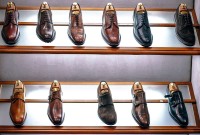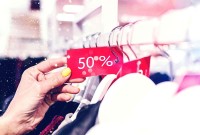- Home
- Business Processes
- Industry Knowledge
- Aerospace Industry
- Automotive Industry
- Banking Domain
- BFSI Industry
- Consumer/ FMCG Industry
- Chemicals Industry
- Engineering & Construction
- Energy Industry
- Education Domain
- Finance Domain
- Hospitality Domain
- Healthcare Industry
- Insurance Domain
- Retail Industry
- Travel and Tourism Domain
- Telecom Industry
- Leadership Skills
- eLearning
- Home
- Industry Knowledge
- Consumer/ FMCG Industry
- Types of Consumer Goods
Types of Consumer Goods
From an economic standpoint, there are three main types of consumer goods: durable goods, nondurable goods, and services. For marketing purposes, consumer goods can be grouped into different categories based on consumer behavior, how consumers shop for them, and how frequently consumers shop for them. One of the largest consumer goods groups is called fast-moving consumer goods. This segment includes nondurable goods like food and drinks that move rapidly through the chain from producers to distributors and retailers than on to consumers.
From an economic standpoint, consumer goods can be classified as:
1. Durable Consumer Goods
Durable goods are consumer goods that have a long life span (e.g. 3+ years) and are used over time. Highly durable goods such as refrigerators, cars, or mobile phones usually continue to be useful for three or more years of use, and hence durable goods are typically characterized by long periods between successive purchases.
These durable goods are referred to as Consumer Durables and examples of consumer durable goods include cars, household goods (home appliances, consumer electronics, furniture, etc.), sports equipment, and toys.
2. Nondurable or Fast Moving Consumer Goods (FMCG)
Useful for less than 3 years, or pure services which are consumed instantaneously as they are produced
FMCG or consumer packaged goods (CPG) are products that are sold quickly and at relatively low cost, examples include non-durable goods such as soft drinks, toiletries, and grocery items. They generally sell in large quantities, so the cumulative profit on such products can be substantial and these industries often operate on thin margins.
Nondurable goods are consumed in less than three years and have short lifespans. Examples of nondurable goods include food and drinks.
The term FMCG refers to those retail goods that are generally replaced or fully used up over a short period of days, weeks, or months, and within one year. This contrasts with durable goods or major appliances such as kitchen appliances, which are generally replaced over a period of several years.
3. Consumer Services
The service industries involve the provision of services to businesses as well as final consumers. Such services include accounting, tradesman ship (like mechanic or plumber services), computer services, restaurants, tourism, etc. The service Industry is the one where no goods are produced. Consumer services refer to the formulation, reformulation, technical consulting, and testing of most consumer products, such as food, herbs, beverages, vitamins, pharmaceuticals, cosmetics, hair products, household cleaners, paints, plastics, metals, waxes, coatings, minerals, ceramics, construction materials plus water, indoor air quality testing, non-medical forensic testing, and failure analysis. It involves services in a wide variety of fields such as biological, chemical, physical, engineering, and Web-based services. Services include auto repairs and haircuts.
Marketing of Consumer Goods
For marketing purposes, consumer goods can be grouped into different categories based on consumer behavior, how consumers shop for them, and how frequently consumers shop for them.
From a marketing standpoint, consumer goods can be grouped into four categories: convenience, shopping, specialty, and unsought goods. These categories are based on consumer buying patterns.
1. Convenience Goods
Convenience goods are those that are regularly consumed and are readily available for purchase. These goods are mostly sold by wholesalers and retailers and include items such as milk and tobacco products.
Convenience goods can be further segmented into staple convenience goods (fulfilling basic customer necessities) and impulse convenience goods (non-priority goods, such as cigarettes).
Examples of convenience products:
- Newspapers and magazines
- Most groceries and food items
- Soft drinks and snack foods and candy bars
- Tissues, headache tablets
- Bread and milk, breakfast cereals
- Toothpaste, soap, and shampoo
- Cleaning products, dish-washing powder, detergents
- Using an ATM
- Cigarettes
- Alcohol
- Coffee, tea, and sugar
- Fast food and takeaway meals
- Pet food
- Flowers
- Fruit and vegetables
- Regular medicines and vitamins
2. Shopping Goods
Shopping goods are those in which a purchase requires more thought and planning than with convenience goods.
Shopping goods are more expensive and have more durability and longer lifespans than convenience goods. Shopping goods include furniture and televisions.
Examples of shopping products:
- Computers
- Mobile phones
- Entertainment equipment, such as an Xbox or PlayStation
- Cameras
- Household furniture
- Washing machines and dishwashers
- Clothing
- Sports equipment
- Kitchen utensils – plates, pots and pans
- Choice of restaurants
- Hotels and airlines
- Luggage
- Getting a pet
- Joining a gym
- Hairdresser and beautician
- Car repairs
- Plants for the yard
- Perfumes and cosmetics
- Running shoes
- Everyday jewelry
- Kid’s bicycles
- Internet provider
- Everyday home loans and credit cards
- House repairs, paint, tools
- Regular doctor and dentist
3. Specialty Consumer Goods
Specialty consumer goods are rare and often considered luxurious. The purchase of specialty goods is reserved for an elite class of shoppers with the financial means to conduct the purchase. Marketing efforts are geared to a niche market, usually the upper class. These products include furs and fine jewelry.
Examples of specialty products:
- Architect designed house
- An expensive car
- Special jewelry
- Planning a wedding
- Wedding dress
- Specialist sporting equipment
- Specialist camping equipment
- Specialist medical advice
- Specialist professional advice – legal, financial
- Home loans for specialist needs
- Some types of computer software
- Extensive international holiday
4. Unsought Consumer Goods
Unsought consumer goods are readily available but are purchased by a few members of the available market. These items are not usually purchased repeatedly and usually serve specific needs, such as life insurance.
Examples of unsought products:
- Life insurance and funeral insurance
- Additional warranties on product purchases
- Encyclopedias
- Charity donations
- Some types of exercise equipment
- Unusual products – perhaps as advertised on the TV shopping channel
- Sometimes new technology (especially when first introduced to the market)
- Raffle tickets
- Fundraising events
5. Fast-Moving Consumer Goods
One of the largest consumer goods groups is called fast-moving consumer goods. This segment includes nondurable goods like food and drinks that move rapidly through the chain from producers to distributors and retailers than on to consumers.
Companies and retailers like this segment as it contains the fastest-moving consumer goods from stores, offering high shelf-space-turnover opportunities.
Some examples of FMCG:
- Toiletries
- Soap
- Cosmetics
- Dental products
- Cleaning products
- Detergents
- Shaving
- Glass
- Light bulbs
- Batteries
- Paper products
Related Links
You May Also Like
-
Challenges in Consumer Goods Industry
There are tens of thousands of general consumer products manufacturers in the United States. They compete to develop the best products at the most affordable price for the greatest number of consumers. Challenges for these organizations include meeting the changing demands of customers, maneuvering through a consolidating market, and executing strategies to grow profitably.
-
From an economic standpoint, there are three main types of consumer goods: durable goods, nondurable goods, and services. For marketing purposes, consumer goods can be grouped into different categories based on consumer behavior, how consumers shop for them, and how frequently consumers shop for them. One of the largest consumer goods groups is called fast-moving consumer goods. This segment includes nondurable goods like food and drinks that move rapidly through the chain from producers to distributors and retailers than on to consumers.
-
Retail Industry - Business Model
A retail business model articulates how a retailer creates value for its customers and appropriates value from the markets. In retail, a business model would dictate the product and/or services offered by the retailer, the pricing policy that he adopts. Many different types of retail establishments exist, and, the overall industry has seen a significant blurring of the boundaries that separated the wide range of retail businesses. Understand the key business models adopted by the retail industry. Understand the distinctive ways that retail industry players use to reach to the end consumer.
-
Consumers benefit from retailing as retailers perform marketing functions that make it possible for customers to have access to a broad variety of products and services. Retailing also helps to create a place, time, and possession utilities. A retailer's service also helps to enhance a product's image. Retailing has a tremendous impact on the economy. It involves high annual sales and employment. Learn the importance of the retail industry in this article.
-
Durable goods are consumer goods that have a long life span (e.g. 3+ years) and are used over time. Highly durable goods such as refrigerators, cars, or mobile phones usually continue to be useful for three or more years of use, and hence durable goods are typically characterized by long periods between successive purchases.
-
The consumer goods sector is a category of stocks and companies that relate to items purchased by individuals and households rather than by manufacturers and industries. These companies make and sell products that are intended for direct use by the buyers for their own use and enjoyment. This sector includes companies involved with food production, packaged goods, clothing, beverages, automobiles, and electronics. Nestle, Procter & Gamble, and Pepsico are some of the world’s largest consumer goods companies in the world.
-
Retailing is the combination of activities involved in selling or renting consumer goods and services directly to ultimate consumers for their personal or household use. In addition to selling, retailing includes such diverse activities as, buying, advertising, data processing, and maintaining inventory. This article explains the meaning of retail and its etymology. Understand the meaning and constituents of the retail industry and the role it plays in the economy of any nation.
-
Markets are continuously changing and to understand the dynamics of any industry it is important to understand what is happening and how the industry market players see the future for the industry. In this article, we will discuss the recent trends witnessed by the retail sector. This document provides insights into major trends identified for the retail sector.
-
Retail Industry Sectors: Types of Retail
A marketplace is a location where goods and services are exchanged. The traditional market square is a city square where traders set up stalls and buyers browse the merchandise. Now retail goods are generally sold in a number of different establishments. Convenience Stores, specialty stores, department stores, supermarkets & hypermarkets, discount stores, multichannel stores are some models used by the retail industry to provide goods to end customers.
-
FMCG or consumer packaged goods (CPG) are products that are sold quickly and at relatively low cost, examples include non-durable goods such as soft drinks, toiletries, and grocery items. They generally sell in large quantities, so the cumulative profit on such products can be substantial and these industries often operate on thin margins.
Explore Our Free Training Articles or
Sign Up to Start With Our eLearning Courses

About Us
Learning
© 2023 TechnoFunc, All Rights Reserved










